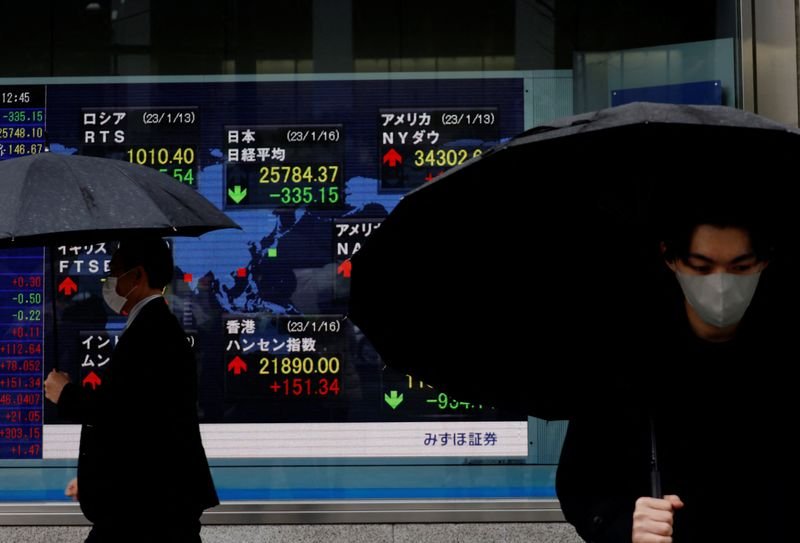© Reuters. FILE PHOTO: Men walk past an electric board displaying Nikkei and other countries’ indexes outside a brokerage in Tokyo, Japan January 16, 2023. The characters on the screen reads,”government bonds”. REUTERS/Kim Kyung-Hoon
By Kevin Buckland and Naomi Rovnick
TOKYO/LONDON (Reuters) -Global stocks were set for their first weekly loss of the year so far, as a rally driven by hopes of China fuelling a global economic recovery was tempered by central bankers vowing to persist with rate hikes.
The MSCI World Price Index edged 0.3% higher into the London morning on Friday, boosted by gains in Asia, after Chinese authorities said on Thursday that the number of COVID-19 patients needing critical care in hospitals had peaked.
The all-country equity gauge was also on course to notch up a loss of around 1.4% for the week, although it remained almost 4% ahead this month following an optimistic start to 2023.
Some analysts say equities had been showing too much optimism about an economic improvement, as both the U.S. Federal Reserve and the European Central Bank remain resolute about continuing to tighten monetary policy to battle inflation.
The share index, which rose 0.1% on Friday, has during the first three weeks of January recovered almost half of its 12.9% loss of 2022. That bounce was driven by China reopening trades and easing prices.
“The [European] market remains unprepared for the wave of pain that is coming from credit conditions tightening,” Andreas Bruckner, European equity strategist at Bank of America (NYSE:), said.
ECB President Christine Lagarde told the World Economic Forum’s Davos gathering on Thursday that the bank would stay the course with raising interest rates.
The U.S. Fed also looks set to sustain its tightening campaign, even after reports on Wednesday showed retail sales, producer prices and production at U.S. factories fell more than expected in December.
On Thursday, U.S. weekly jobless claims were lower than expected, pointing to a tight labour market and sending Wall Street’s share gauge 0.8% lower.
Boston Fed President Susan Collins said the central bank would probably need to raise rates to “just above” 5%, then hold them there, while Fed Vice Chair Lael Brainard said that despite the recent moderation in inflation, it remains high and “policy will need to be sufficiently restrictive for some time”.
Those comments by “usually reliable Fed dove” Brainard in particular are “compounding rate hike fears”, said Tony Sycamore, an analyst at IG.
“The labour market is just a little too hot to back off,” Sycamore added.
The market expects the Fed’s benchmark interest rate will be a touch below 5% in June, implying just over 50 basis points of additional tightening.
On Friday morning, ticked 0.3% higher.
The – which measures the U.S. currency against six peers, including the euro and yen – edged 0.14 higher to 102.17, adding a bit more distance from the 7-1/2-month low of 101.51 reached on Wednesday.
The benchmark was around 3.4% after bouncing off the lowest since mid-September at 3.321% overnight.
In Asia, Japanese government bond yields stayed depressed.
The 10-year JGB yields slipped half a basis point to 0.4%, hovering around that level since getting knocked back from above the Bank of Japan’s 0.5% policy ceiling on Wednesday, when the central bank refrained from further tweaks to its yield curve controls.
The yen, which has been volatile as traders debate when the BOJ might eventually abandon its controversial policy of buying up vast quantities of JGBs to suppress borrowing costs, weakened 0.5% to 128.9 per dollar.
Elsewhere, crude oil prices continued to rise. futures for March delivery gained 30 cents, or 0.35%, to $86.46 a barrel, while advanced 49 cents to $80.82 per barrel, a 0.6% gain.








